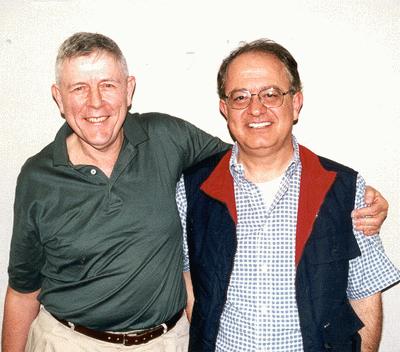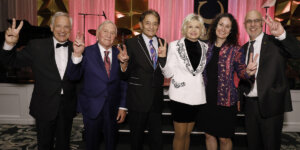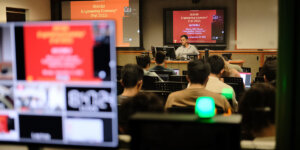
USC School of Engineering Dean Max Nikias with ISI Executive Director and Associate Dean Herbert Schorr
In a broad-ranging talk at ISI, Dean Max Nikias laid out his plans to bring the USC School of Engineering into the elite inner circle, and explained how Engineering’s “hidden jewel,” ISI, will be part of those plans, developing into a full-fledged “second
Nikias said Schorr’s appointment to dean status, announced August 17, was taken for two reasons: first, because of the importance of ISI to the School, and second, “because of Herb’s personal qualities. I look forward to having him at my weekly meetings.”Nikias became dean of the school in June. Armed with a data-packed PowerPoint presentation about the position of the school in relation to MIT, Stanford, the UC system, Cornell, Carnegie-Mellon and other top institutions, he addressed ISI staff and faculty for more than an hour in July, pausing for numerous questions.
His plan to improve the School is multifaceted, but centers around an audacious step that will be taken in the relatively short term: — increasing the number of tenure track faculty by roughly 30 percent. Many of these new hires will be in the area of the school’s greatest strength, EE and Computer Science, which, when added to ISI, IMSC, ICT, and resources in the Annenberg and Cinema Schools and the Annenberg Center are in Nikias’s view a unique complex of talent and potential growth.
The new dean intends that a substantial number of new faculty will have joint appointments at ISI — and not necessarily just in the obvious fields of EE and CS.
Many other new professors will join selected other areas — certainly biomedical engineering and likely others as well — with the aim of developing at least two other nationally ranked top-10 departments. ISI alliances were possible with these too, he indicated.
Nikias said that all the top schools he wished to bring USC among had at least three or four department ranked near the top nationally.
The recruitment will take place on the theory that top faculty are able to essentially pay for themselves in research support. Nikias said this was now essentially true at USC, where research grants to tenure-track faculty generates funding roughly equal to the amount paid in salary and benefits to the same group.
Following on this theory, fundraising will focus only partly on new named chairs, though these will be critical. It will also attempt to increase the support for the school to offer fellowships and other support to students, particularly graduate students.
Space for the new hires, said Nikias, would be found without new buildings, except for the already planned Tutor Engineering building. Instead, the school will move quickly to renovate space in existing older buildings like Biegler Hall, Rapp Hall, and others, space which is underutilized at least in part because it is now substandard.
Specifically for ISI, Nikias also mentioned other short-term steps. Subventions from the provost to the School, he noted, were supposed to be “used like venture capital,” to fund new, somewhat speculative demonstrations and other projects to draw attention to the school.
An early priority is a demonstration of next generation Internet applications, proposed by an ISI/IMSC team.
Nikias also promised to better recognize ISI faculty contributions —and even adjust compensation for classes they taught. He said that Gerard Medioni, the new chair of the computer science department, had noted that ISI faculty tend to teach more “difficult” classes — larger and more demanding. He promised that the old system of pay based solely on units taught would be re-examined to take the difficulty factor into consideration.
His goal of making ISI a “second campus” for the school of engineering would largely be fulfilled, he said, through the School’s Distance Education Network (DEN). DEN’s will be expanded so that classes at ISI would be accessible from the University Park campus remotely, and “ISI would have a great role in DEN,” Nikias said.
And his proposed enhanced fundraising effort, he noted, will put ISI in play as a potential naming opportunity, so that the Institute might become USC’s [large donor’s name] Information Sciences Institute. A goal, he said, would be to supplement the Institute’s base ongoing application for research funding — successful as this has been — with an endowment, creating what he called “pseudo-tenure” for researchers which would free them to work on longer time horizons and more ambitious projects.
Other Nikias plans were grouped around or supplemented his central goal of recruitment. Fast track recruitment of faculty, he noted would improve the university’s faculty-to-student ratio, which is now among the highest among leading engineering schools. He laid out a general cycle: better faculty would lead to more research, leading to better reputation, attracting better students, creating more facilities, helping the recruitment of better faculty.
Regarding students, Nikias noted that USC engineering has one of the highest percentages of non-American citizen students of any high ranking school, with foreigners outnumber Americans 2-1, rather than the 1-1 ratio that is the rule elsewhere. (One artifact of this is the fact that while USC engineering students score comparably with all other schools on the mathematical SATs and analytical GREs, verbal scores on both exams are much lower, reflecting many non-native speakers of English.)
This situation causes difficulties supporting teaching and research associates, since many U.S. government fellowship program are limited to citizens. While a majority of Stanford students, for example, enjoy such fellowships, relatively few USC students do. To address this situation, Nikias proposed taking steps with other American universities to increase applications from Americans.
Nikias also reported that he was completely revamping the engineering development office, organized into three tracks, a fundraising/advancement group; an alumni relations outreach effort, and public relations.
Public relations, he noted explicitly, “is an important component. We want to do it right. We want to communicate all the successes in carrying out the program.”
Communication, he noted, was essential because for graduate school rankings like those of the US News & World Report, a key element is reputation among recruiters and other schools — and “our perception ratings are consistently low” he said, in comparison with other, less subjective measures.
Nikias also mentioned corporate involvement as another key element he would emphasize. In addition to pursuing its internal agenda, the School of Engineering, he said, would be, as part of the University, supporting the university-wide strategic plan, with its emphasis on bioscience, communications, the arts, and the urban paradigm.
Engineering would be launching initiatives in a number of areas, he said, and “each initiative, no matter how small,” would recruit a corporate council and other corporate input.
Nikias, who was careful to note that he had spent much time with ISI Executive Director Herbert Schorr in making these plans for USC, concluded on a positive note:
“We can’t lift the School of Engineering into the top five or seven schools without ISI,” he said, and proposed breaking down barriers that have sometimes troubled relations between Marina del Rey and University Park.”
“On behalf of the School of Engineering,” he continued, “I apologize for the way you’ve sometimes been treated in the past. I now want to hear your ideas. Let’s all work together.”
Published on September 14th, 2001
Last updated on August 10th, 2021











